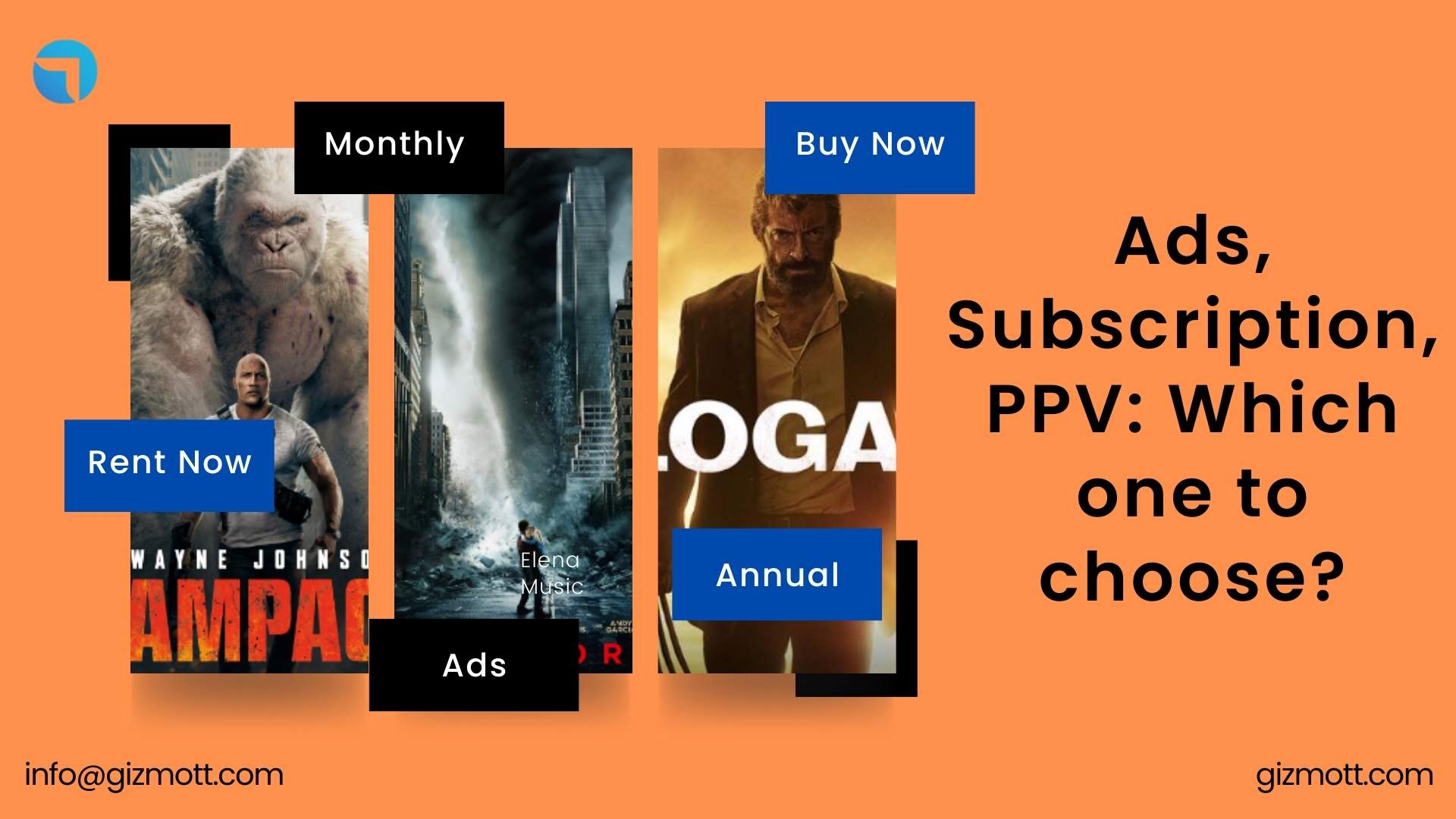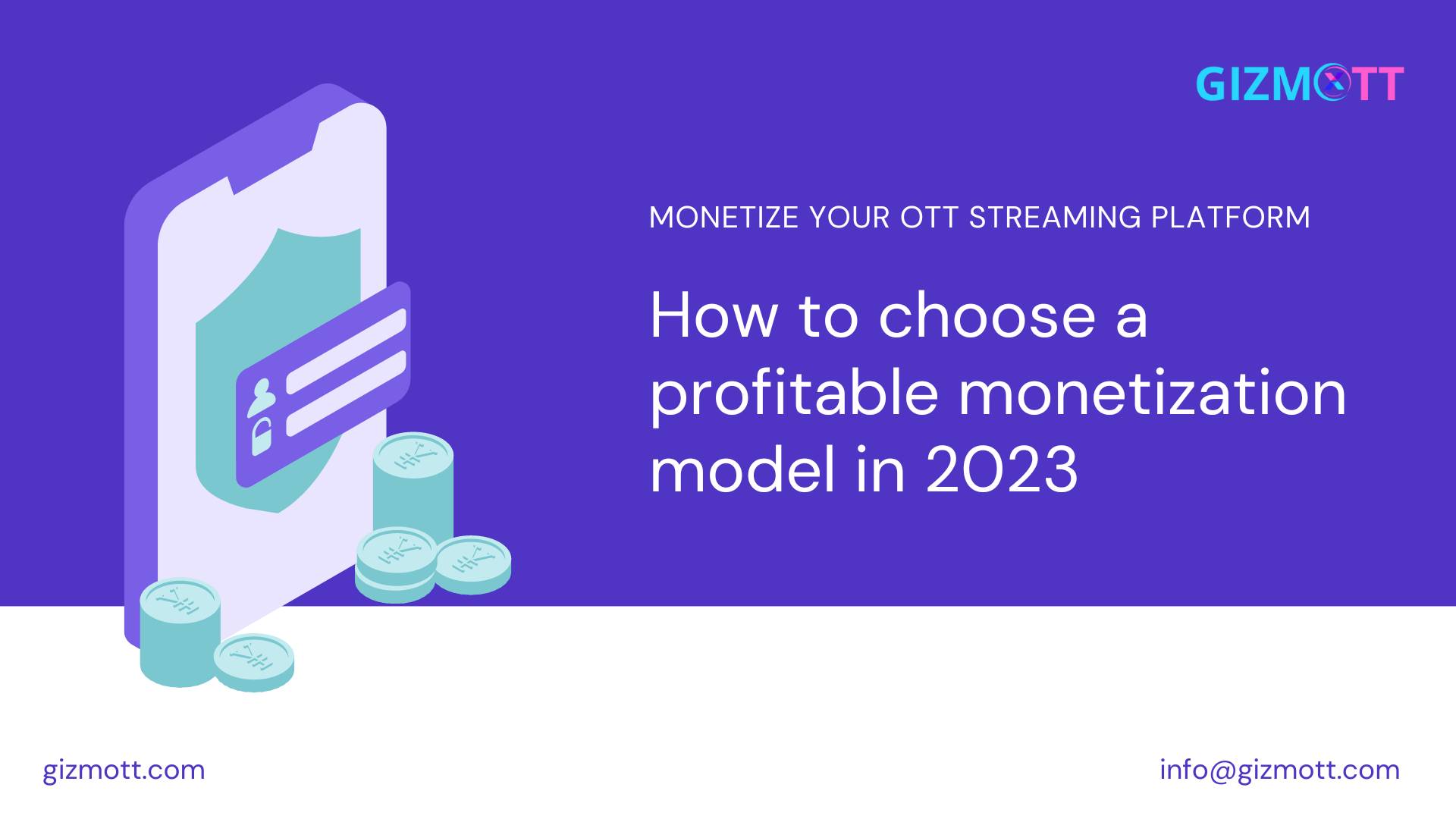Now that it’s been 3 years into the pandemic, majority of the general public has adopted this trend of over-the-top services. Launching an OTT platform helps you reach a wider audience and generate substantial revenue. One of the first crucial decisions one makes when creating an OTT service is how you will monetize your content.
Choosing the right video monetization model is a foundational component of monetizing your video content. Here’s how to decide between SVOD, TVOD, and other monetization options.
Selecting an online video platform with suitable monetization tools is necessary before you start generating revenues from OTT video. This is where Gizmott comes in. You can launch, stream, monetize and distribute video content globally with our seamless OTT platform.
In this post, we aim to help you make informed decisions about the OTT marketplace, the different methods for monetizing your content and some practices to keep in mind while choosing the appropriate revenue model.
What are OTT revenue models?
Today’s broadcasters/content creators want to experiment with different revenue models and are looking for flexibility in their go-to-market strategies.
Thousands of OTT broadcasters are currently offering their clients niche material or an assortment of the most popular content. A multi-experience OTT platform with the appropriate monetization model is used by all profitable companies to generate income. However, if we were to group these OTT revenue models, we would find that there are only a few single-digit ways for thousands of OTT firms to generate revenue.
Broadcasters, content creators or media production companies can choose from six main OTT monetization options. Let’s examine each OTT monetization strategy and how it might benefit your company’s growth.
Popular OTT Revenue Models.
1. Advertising based monetization (AVOD)
One of the most widely used methods of monetizing videos is advertising video on demand (AVOD). Viewers can have free access to content via the AVOD approach. By charging advertisers to display their advertising on the platform, OTT players can generate revenue.
Gizmott enables you to sell your videos through ads for on-demand or live streaming. A d Servers and Ad Exchanges can be integrated with Gizmott’s HTML5 video player. You can to create your own video streaming platform, and combine it with our ad-server to precisely deliver advertisements to your viewers based on their streaming preferences, whether they prefer in-content or display ads.
This model performs well when the audience is made up of a variety of audience segments and is willing to accept commercials in exchange for a reduced subscription fee.
2. Subscription based monetization (SVOD)
Subscription-based businesses that offer subscription video on demand (SVOD) services charge a recurring price weekly, monthly, quarterly, or yearly for full access to their video platform. Netflix was the first to popularize the SVOD strategy, and it is still the most widely used OTT business model today.
The advantage for viewers is that for a minimal charge, they get access a huge library of movies that they can view as often as they choose. With this model, revenue is consistently generated, and membership tiers can be adjusted to reflect changes in strategy.
It works best for niche content or for those who prefer continuous streaming over ads. Gizmott lets you to monetize your on-demand and live videos by providing your audience with the option of Subscription.
3. Transactional based monetization (TVOD)
Transactional Video on Demand is also referred to as the Pay-Per-View or rental model where users can buy or rent a piece of content. Instead of a time-based subscription, consumers pay only for the content they want to watch under this approach.
So instead of having access to a huge library, they are only charged for the content they watch. This technique is frequently used by broadcasters to upsell services that are not always included in the basic subscriber package and to increase revenue.
Since there is no membership cost, anyone can purchase your content. TVOD is targeted for wider audiences who might not be consistent. TVOD should be used to promote exclusive or original content and should offer a range of pricing options
4. Premium based monetization (PVOD)
With Premium Video on Demand, users can pay to watch content earlier than normal SVOD or TVOD subscribers would. Users can access the OTT platform and watch their preferred content by just paying a certain premium fee. Depending on the OTT service provider, access to PVOD content might be either permanent or limited to a single viewing.
Following the pandemic, the premium model has seen tremendous growth in popularity. The world’s major studios rapidly discovered it as an efficient digital alternative to release their films because theatres were shut and viewers were stuck at home.
Investing in the PVOD model creates the opportunity to reach a larger audience and generate more revenue.
5. Hybrid
Hybrid model is a mix of the above-mentioned models where some content is free, revenue is generated from ads, and the rest is paid for. This concept is adopted by many OTT platforms because it offers a higher chance to attract and retain subscribers.
By offering tier-based membership plans and gate-keeping some content so that only users who are ready to pay a premium can access it, providers can take this approach a step further.
Hybrid business model is the most efficient approach for video businesses to increase their revenue when combined with the appropriate technology and business expertise. But most significantly, everybody benefits.
6. Donations
Donation-based or crowdfunding is another monetization model that is free to watch and solely depends on the individual viewer’s desire to support a particular artist, cause, or religious gathering. By using an integrated “donate” button, viewers can make a donation without leaving the program.
Gizmott offers this one-of-a-kind monetization technique to help you make the most of your production budget. All you have to do is create a donation target for your content, allow your end users to make shop credit donations, and crowdfunding will display the percentage of the target that has been achieved.
Some revenue generating tips to consider when monetizing OTT content.
There are a few recommended tips to remember when it comes to OTT video monetization, regardless of the strategy you use. Let’s take a moment to go over some of the aspects of OTT video monetization that you need to be aware of.
• Payment Security
Security is a key factor to keep in mind when handling money. Users will want to pay on a secure platform that doesn’t hold confidential information or leak it to the wrong parties. That means payment information must be encrypted using approved bank-grade procedures.
When users enter their payment information on an unsecure website, most modern browsers often issue a warning. Gizmott uses industry-standard security procedures to protect client payment information from unauthorized attacks and interception.
• Secure Video Delivery
It is essential to choose a video platform that offers safe and secure video distribution when an operator shares their content online. The content should be safeguarded against any piracy intercepts that could duplicate and distribute it, particularly when you are monetizing the content.
This is necessary from both a safety and content owner’s perspectives. At Gizmott, we use tokenized security to identify and stop unauthorized video embeds before they may cause problems.
• Server-Side Ad Insertions
Server-side integrations weave transcoded advertisements into ordinary video streams so that the viewing experience doesn’t change and viewers aren’t interrupted by ads. Gizmott enables cross-platform monetization, which is made possible by SSAI and also hides relevant ads from ad blockers.
Inserting advertisements on the server before the video is seen by viewers is one approach to get past many ad-blockers. This technique helps you maximize your revenue and is quickly becoming the industry standard.
• Marketing Plans
For an effective OTT video monetization, you need a marketing strategy. You must carefully organize and distribute your content while providing an OTT service.
An essential strategy to create buzz and enthusiasm, as well as help in the service’s monetization and expansion, is to pre-sell your video material.
Launch with Gizmott.
Each monetization strategy has advantages and disadvantages of its own. Analysing the advantages and disadvantages of each platform is necessary if you want to create a successful OTT platform. Finding the ideal blend of monetization techniques that will appeal to your audience is the key to success.
Regardless of the monetization model you choose, you must have a business strategy to drive revenue from your content consistently. For this, you’ll need a platform like Gizmott, to manage and monetize your video streaming strategy. To get started, visit our website or drop us a line at info@gizmott.com.


